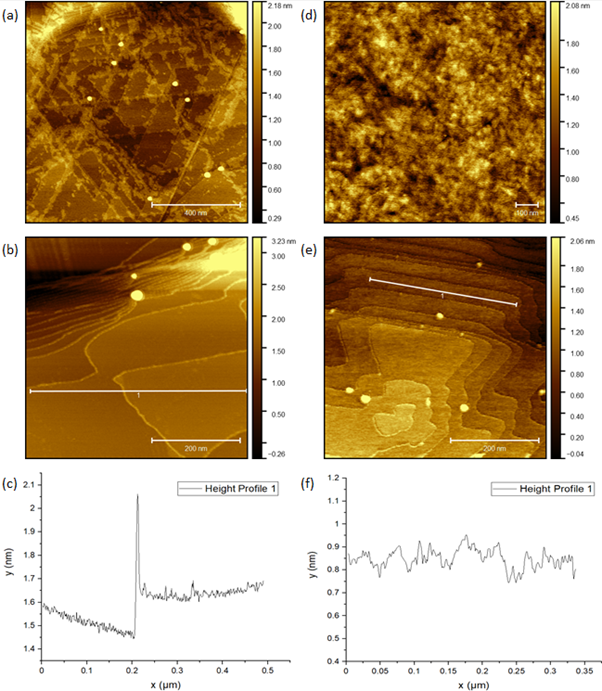Quantifying the Effect of Gold Flame Annealing on Molecular Self-Assembly
- Abstract number
- 215
- Presentation Form
- Contributed Talk
- DOI
- 10.22443/rms.mmc2023.215
- Corresponding Email
- [email protected]
- Session
- Nanoscale Science of Materials for Energy Storage and Generation
- Authors
- Charlie Wells (1), Elisabeth Bancroft (1), Stuart Finch (1), Dr Benjamin Robinson (1), Dr Samuel Jarvis (1)
- Affiliations
-
1. Lancaster University
- Keywords
Flame Annealing
Molecular Electronics
Self-Assembled Monolayers
Atomic Force Microscopy
X-ray photoelectron spectroscopy
- Abstract text
The observation of room temperature quantum interference (QI) effects in single molecules has opened up new possibilities for molecular electronics and thermoelectric materials. Molecular junctions are generally modelled and simulated using idealised contacts between the molecule and electrodes, something which does not translate easily to experiment when dealing with molecular films. Despite this, several recent reports now demonstrate that single-molecule QI effects can be translated into self-assembled monolayers (SAMs) [1-3], which retain excellent thermoelectric properties, even with the absence of long-range order within the layers. The common wisdom is that to improve on this, the surface quality must be improved such that molecular ordering and the consistency of surface-molecule contacts must be improved, however, quantification of this effect, particularly on thermoelectric properties, remains lacking.
Here we explore gold substrates prepared using a variety of methods, including template-stripped gold [4], epitaxial Au(111) on mica [5], and ‘rough’ gold on quartz. We then apply a range of flame annealing methods and monitor the improvement in surface structure with X-ray photoelectron spectroscopy (XPS) and atomic force microscopy (AFM). Figure 1 shows two examples of Au(111):mica and template-stripped gold before and after annealing, where, surprisingly, even polycrystalline template stripped gold is found to exhibit large regions of Au(111) structure. We will discuss the impact of SAMs prepared on these and other substrates, where we aim to quantify the effect of surface roughness using an archetypal thermoelectric molecule.
Figure 1: AFM images of gold on mica (a) before annealing (b) after annealing at 600°C for 1 minute. (c) A line profile taken from the annealed image. AFM images of template-stripped gold (d) before annealing (e) after annealing at 580°C for 18 seconds. (f) A line profile taken from the annealed image.
- References
[1] Ismael A, Wang X, Bennett TL, Wilkinson LA, Robinson BJ, Long NJ, Cohen LF, Lambert CJ. Tuning the thermoelectrical properties of anthracene-based self-assembled monolayers. Chemical science. 2020;11(26):6836-41.
[2] Bennett TL, Alshammari M, Au-Yong S, Almutlg A, Wang X, Wilkinson LA, Albrecht T, Jarvis SP, Cohen LF, Ismael A, Lambert CJ. Multi-component self-assembled molecular-electronic films: towards new high-performance thermoelectric systems. Chemical Science. 2022;13(18):5176-85.
[3] Wang X, Sangtarash S, Lamantia A, Dekkiche H, Forcieri L, Kolosov OV, Jarvis SP, Bryce MR, Lambert CJ, Sadeghi H, Robinson BJ. Thermoelectric properties of organic thin films enhanced by π–π stacking. Journal of Physics: Energy. 2022 Mar 23;4(2):024002.
[4] Wagner P, Hegner M, Guentherodt HJ, Semenza G. Formation and in situ modification of monolayers chemisorbed on ultraflat template-stripped gold surfaces. Langmuir. 1995 Oct;11(10):3867-75.
[5] Lüssem B, Karthäuser S, Haselier H, Waser R. The origin of faceting of ultraflat gold films epitaxially grown on mica. Applied surface science. 2005 Aug 15;249(1-4):197-202.

